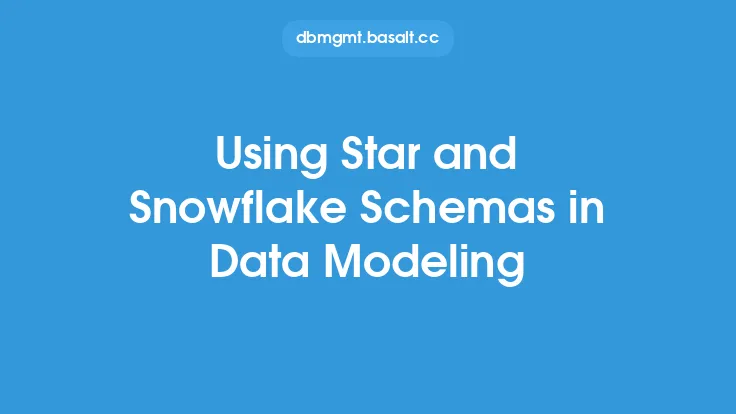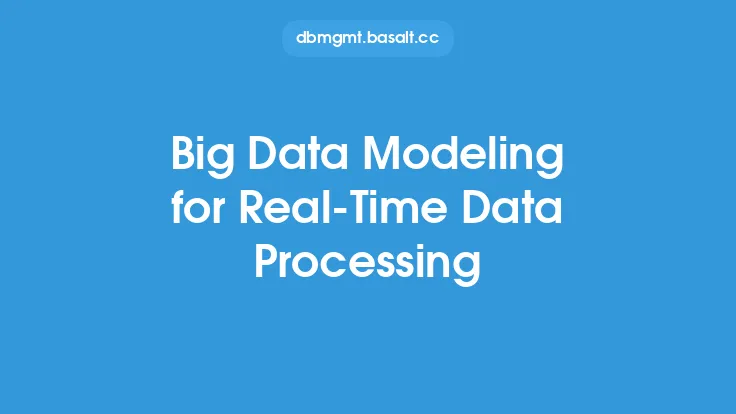The increasing volume, variety, and velocity of big data have led to a significant shift in the way data is stored, processed, and analyzed. Traditional relational databases, which were designed to handle structured data, are no longer sufficient to handle the complexities of big data. This is where NoSQL databases come into play, offering a flexible and scalable solution for big data modeling. In this article, we will delve into the world of big data modeling and NoSQL databases, exploring their key concepts, benefits, and applications.
Introduction to NoSQL Databases
NoSQL databases, also known as non-relational databases, are designed to handle large amounts of unstructured or semi-structured data. They offer a flexible schema, which allows for easy adaptation to changing data structures, and are optimized for high performance and scalability. NoSQL databases are categorized into several types, including key-value stores, document-oriented databases, column-family stores, and graph databases. Each type of NoSQL database is suited for specific use cases, such as handling large amounts of user data, storing complex documents, or analyzing relationships between data entities.
Big Data Modeling Concepts
Big data modeling involves creating a conceptual representation of big data, which includes defining the structure, relationships, and constraints of the data. Big data modeling concepts are similar to traditional data modeling concepts, but with some key differences. Big data models must be able to handle large volumes of data, high data variety, and high data velocity. They must also be able to adapt to changing data structures and schemas. Some key big data modeling concepts include data entity, attribute, relationship, and data type. Data entities represent real-world objects or concepts, attributes represent the characteristics of data entities, relationships represent the connections between data entities, and data types represent the format of the data.
NoSQL Data Modeling Techniques
NoSQL data modeling techniques are used to design and implement NoSQL databases. These techniques involve creating a data model that is optimized for the specific NoSQL database being used. Some common NoSQL data modeling techniques include denormalization, data duplication, and data aggregation. Denormalization involves storing data in a single collection or table, rather than splitting it across multiple tables. Data duplication involves storing multiple copies of data to improve performance and availability. Data aggregation involves storing pre-computed results to improve query performance.
Benefits of Using NoSQL Databases for Big Data Modeling
NoSQL databases offer several benefits for big data modeling, including flexibility, scalability, and high performance. NoSQL databases are flexible, allowing for easy adaptation to changing data structures and schemas. They are also scalable, allowing for easy addition of new nodes or servers to handle increasing data volumes. NoSQL databases are optimized for high performance, allowing for fast data retrieval and processing. Additionally, NoSQL databases are often designed to handle large amounts of unstructured or semi-structured data, making them well-suited for big data applications.
Applications of Big Data Modeling and NoSQL Databases
Big data modeling and NoSQL databases have a wide range of applications, including social media analytics, IoT data processing, and real-time recommendation systems. Social media analytics involves analyzing large amounts of user data to gain insights into user behavior and preferences. IoT data processing involves processing and analyzing large amounts of sensor data from IoT devices. Real-time recommendation systems involve analyzing user behavior and preferences to provide personalized recommendations. Other applications of big data modeling and NoSQL databases include fraud detection, predictive maintenance, and customer segmentation.
Best Practices for Big Data Modeling and NoSQL Databases
To get the most out of big data modeling and NoSQL databases, it's essential to follow best practices. Some best practices include defining a clear data model, using a flexible schema, and optimizing for performance. Defining a clear data model involves creating a conceptual representation of the data, including the structure, relationships, and constraints. Using a flexible schema involves using a schema that can adapt to changing data structures and schemas. Optimizing for performance involves using techniques such as denormalization, data duplication, and data aggregation to improve query performance.
Tools and Technologies for Big Data Modeling and NoSQL Databases
There are several tools and technologies available for big data modeling and NoSQL databases, including data modeling tools, NoSQL databases, and big data processing frameworks. Data modeling tools, such as Entity-Relationship diagrams and data modeling software, are used to create and manage data models. NoSQL databases, such as MongoDB and Cassandra, are used to store and process big data. Big data processing frameworks, such as Hadoop and Spark, are used to process and analyze big data. Other tools and technologies include data integration tools, data quality tools, and data governance tools.
Conclusion
In conclusion, big data modeling and NoSQL databases are essential for handling the complexities of big data. NoSQL databases offer a flexible and scalable solution for big data modeling, and are optimized for high performance and scalability. Big data modeling concepts, such as data entity, attribute, relationship, and data type, are used to create a conceptual representation of big data. NoSQL data modeling techniques, such as denormalization, data duplication, and data aggregation, are used to design and implement NoSQL databases. By following best practices and using the right tools and technologies, organizations can get the most out of big data modeling and NoSQL databases, and gain valuable insights into their data.





